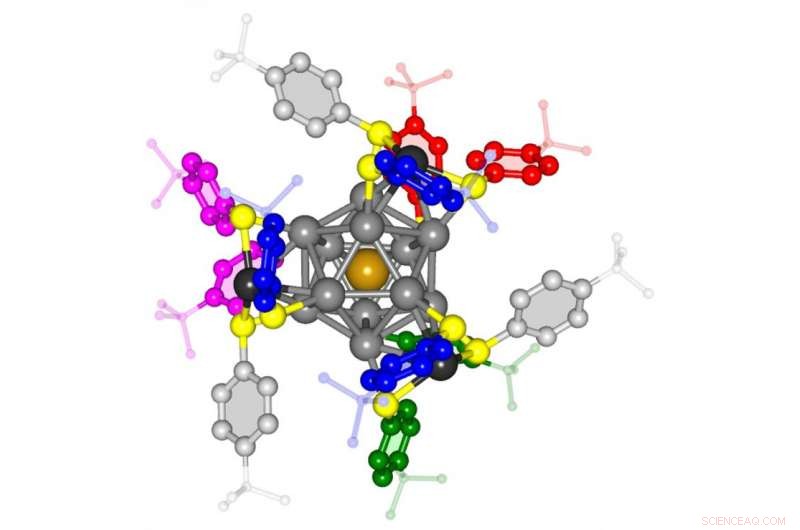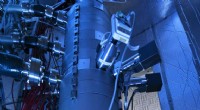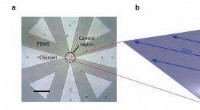Hybrid tilgang forudsiger og bekræfter strukturen af komplekse metal nanopartikler

Strukturudviklingsspiral af AuAg 16 (SR) 12 klynge. Opbygningen af strukturen af det organiske monolag-kapslede metalliske AuAg 16 klynge er vist startende fra det centrale enkelt guldatom i midten og dets indkapsling af 12 sølvatomer (grå) i en AuAg 12 icosahedron. Afdækning af AuAg 12 kerne gennem forankring af organiske benzenholdige molekyler via svovlholdige monteringer (AuAg 16 S 12 ) kulminerer i dannelsen af den monolag-kapslede klynge AuAg 16 (SR) 12 , med de aromatiske ringe i det afdækkende monolag, der udviser unikke dimer- og trimerbundtede strukturer. Kredit:Georgia Tech / UT
En kombineret teoretisk og eksperimentel tilgang har gjort det muligt for forskere at forudsige og verificere den fulde struktur af en monolag-coated molekylær metal nanopartikel. Metoden blev testet på sølv-thiolat nanopartikler, udvidelse af tidligere viden om guld nanopartikler, og forventes at være anvendelig til en bred vifte af størrelser af nanopartikler lavet af forskellige grundstoffer.
I en avis offentliggjort fredag, 25. november, 2016, i journalen Videnskabens fremskridt , forskere fra Georgia Institute of Technology og University of Toledo rapporterer om en røntgenbestemt struktur, der autentificerer a priori forudsigelsen, og i forbindelse med første-princippets teoretiske analyse, understøtter den underliggende prognosemetode.
"Metalnanopartikler dækket af organiske ligander har grundlæggende og anvendt betydning for forståelsen af de fysiske og kemiske principper, der styrer samlingen og atomorganiseringen i nanokrystallinske materialer, og deres potentielle brug i felter som kvanteprikker, sensorer, nanokatalysatorer, biomedicinsk billeddannelse, nanokrystallinske supergitter og plasmonik, " sagde Uzi Landman, Regent's Professor og F.E. Callaway Chair i Georgia Tech School of Physics. "Vi har været engageret i undersøgelser af de principper, der ligger til grund for strukturerne af atomare og molekylære nanoklynger, med nogle af vores tidligere forudsigelser lavet for over to årtier siden, og dermed, i en eller anden forstand, præstationen demonstreret i dette papir lukker en cirkel for os, peger vejen mod fremtidig videnskab, der styrer atomisk præcise strukturer i denne skala."
Forskningen blev støttet af National Science Foundation, luftvåbnets kontor for videnskabelig forskning, og US Department of Energy's Office of Basic Energy Sciences. Beregningsmæssig forskning blev udført på Georgia Tech Center for Computational Materials Science.
Siden 1990'erne, forskere har undersøgt de unikke egenskaber ved metalliske nanopartikler, hvis overflader er blevet passiveret vha. hovedsagelig, svovlbaserede organiske materialer. Disse thiol-kapslede strukturer, sammensat af snesevis til hundredvis af atomer, har unikke optiske og elektriske egenskaber afhængigt af metallernes kemiske identitet, antallet af metalatomer i nanopartikelkernen, og typen og antallet af capping organiske ligander – som alle bestemmer nanopartiklernes struktur.
At forudsige strukturen af sådanne nanopartikler er et formidabelt teoretisk mål, og en eksperimentel udfordring. Nanopartikler lavet af forskellige metaller – guld, sølv, platin, kobber, og deres legeringer – kan dannes med størrelser fra snesevis op til hundredvis af atomer, kendetegnet ved metalspecifikke diskrete sekvenser af antal atomer, der afspejler præferencestabiliteter og højere forekomster af nanopartikler af specifikke størrelser. De atomare bestanddele i sådanne stabile nanopartikler er organiseret i strukturer, der adskiller sig fra de tilsvarende bulk-atomarrangementer af de indgående metaller. Overfloden af forskellige strukturer, der således dannes, forklarer variabiliteten og mangfoldigheden i de fysiske og kemiske egenskaber af sådanne nanomaterialer i finit-størrelse. I øvrigt, metalnanopartiklerne er dækket af svovlholdige ligander, hvis binding til metalbestanddelene yderligere komplicerer de strukturelle forudsigelser, Landman bemærkede.
"Der er ofte noget, der ligger til grund for overfloden og den atomare organisation i sådanne partikler, som er subtilt og usædvanligt, Landman sagde. "Interaktionerne varierer baseret på konkurrerende effekter. Vi lærte, hvor komplicerede virkningerne af ligandbindingen kan være, og hvordan man integrerer denne viden i en strukturforudsigelsesstrategi."

Den de novo-forudsagte og røntgen-bekræftede struktur af det organiske thiol-kapslede AuAg 16 (SR) 12 klynge. Klyngen består af en central icosahedral (AuAg 12 , made of a gold atom surrounded by twelve silver atoms), capped by four AgS 3 mounts, each made of a triangle of sulfur atoms, in yellow, bonded to an anchoring silver atom (black). Each of the twelve sulfur atoms is bonded to an aromatic phenyl ring which is crowned by a tetrabutyl group C(CH 3 ) 3 . Most of the aromatic rings are organized in dimer bundles (ring dimers pink, red and green) and a cyclic trimer (blue rings), with the rest three rings remaining unbundled (light gray). Kredit:Georgia Institute of Technology
Using concepts from nucleation theory and judiciously chosen trial structural motifs, taken in part from earlier studies, in conjunction with first-principles quantum-mechanical structure-optimization computational techniques, the researchers advanced in an earlier study (published in 2015 in the Journal of the American Chemical Society ) a de novo predicted structure for the capped silver nanoparticle. This prediction was largely borne out by the subsequent experimentally determined structure accomplished by a group of researchers headed by Professor Terry Bigioni from the department of Chemistry at the University of Toledo.
I den Videnskabens fremskridt paper, the researchers present an experimental X-ray total structure determination and theoretical optimization and analysis of the atomic arrangement in the nanoparticle whose chemical formula is (TOA) 3 AuAg 16 (TBBT) 12 , where TBBT (4-tert-butylbenzenethiol) denotes the organic thiol ligand molecules, and TOA (tetraoctylammonium) serves as a counterion. The inner part of the nanoparticle consists of a central gold atom surrounded by twelve silver atoms, forming a 13-atom five-fold-symmetric icosahedral metal core. The organic ligands have been predicted, and experimentally confirmed, to be anchored to the metal core though bonding to additional four silver atoms, forming four-Ag (TBBT) 3 capping mounts.
Along with the emergence of the novel mount-motif family for silver-thiolate nanoparticles, the study compares in detail the observed and predicted structural, electronic and spectral properties of the monolayer-protected gold-atom-doped silver nanoparticle, largely confirms the de novo structure prediction as well as identifies accessible rotational isomeric ligand-shell conformations, validates the structure forecasting methodology, and provides impetus for further experimental and theoretical developments.
Among the highlights of the reported research was the growing cognition concerning the possible role of the organic ligands in controlling the structure of the nanoparticle.
"If you modify the capping agent, you may modify structures, and that is a radical paradigm change, " Landman said. "Usually, you would expect the metal nanoparticles to arrange in ways dictated by their intermetallic interactions, with only mild influence from the capping organic molecules."
Another highlight pertains to ordering within the ligand shell, which was theoretically predicted 20 years ago in the context of investigations of capped gold nanoparticles, known as "ligand bundling." Subsequently, such ligand orderings have been confirmed in various instances. The identification of intermolecular ligand bundling in the present work, with the emergence of perennial noncovalent phenyl-ring assemblies in the form of a cyclic trimer and T-shape-like dimers, is of relevance to molecular recognition, self-assembled supramolecular architecture, crystal packing, biomolecule (DNA and protein) structures, and quantum-chemistry benchmark studies.
"These findings demonstrate key principles underlying ligand-shell anchoring to the metal core, as well as unique T-like benzene-dimer and cyclic-benzene-trimer ligand bundling configurations, opening vistas for rational design of metal and alloy nanoparticles, " the authors said in the paper. The study "provides an impetus and guidance for continued efforts toward formulation and implementation of structure prediction methodologies for such complex materials systems."
The principles underlying the ligand-shell structure also imply that the structure of bimetallic nanoparticles could be influenced by the coordination of the metal atoms in the ligand shell. For eksempel, if the coordination of the heteroatoms is not compatible with the ligand shell structure, then those heteroatoms will be located in the metal core. Ja, heteroatom substitution can be used in this sense as a structural probe. If the incompatible metal atoms are located in the ligand shell, imidlertid, then the structure of the nanoparticle will not be conserved, due to structural changes in the ligand shell necessitated by the different heteroatom bonding requirements.
 Varme artikler
Varme artikler
-
 Ingeniør bringer nyt twist til natriumionbatteriteknologi med opdagelse af fleksible molybdendisulf…En ingeniør fra Kansas State University har fået et gennembrud inden for genopladelige batteriapplikationer. Det nederste billede viser en selvstændig molybdendisulfid/grafen-kompositpapirelektrode, o
Ingeniør bringer nyt twist til natriumionbatteriteknologi med opdagelse af fleksible molybdendisulf…En ingeniør fra Kansas State University har fået et gennembrud inden for genopladelige batteriapplikationer. Det nederste billede viser en selvstændig molybdendisulfid/grafen-kompositpapirelektrode, o -
 Forskere udvikler en metode til at observere nanokrystaldannelse ved atomopløsningStudie medforfatter Xiaoqing Pan, direktør for Irvine Materials Research Institute ved UCI, sagde, at den nye teknik til billeddannelse af omdannelsen af en precursorforbindelse indeholdende platin
Forskere udvikler en metode til at observere nanokrystaldannelse ved atomopløsningStudie medforfatter Xiaoqing Pan, direktør for Irvine Materials Research Institute ved UCI, sagde, at den nye teknik til billeddannelse af omdannelsen af en precursorforbindelse indeholdende platin -
 Brug af enkelt kvantepunkter til at undersøge nanotråde(a) Dette er et optisk billede af den mikrofluidiske enhed med krydsede kanaler. Flow i centerkontrolområdet (stiplet cirkel) manipuleres i to dimensioner af 4 eksterne elektroder (ikke vist). Målesta
Brug af enkelt kvantepunkter til at undersøge nanotråde(a) Dette er et optisk billede af den mikrofluidiske enhed med krydsede kanaler. Flow i centerkontrolområdet (stiplet cirkel) manipuleres i to dimensioner af 4 eksterne elektroder (ikke vist). Målesta -
 Nyt antibakterielt materiale til bandager, fødevareemballage, skoEn ny form for papir fremstillet af supertynde karbonark kan hjælpe med at bekæmpe sygdomsfremkaldende bakterier i applikationer lige fra antibakterielle bandager til mademballage. Kredit:ACS Nano
Nyt antibakterielt materiale til bandager, fødevareemballage, skoEn ny form for papir fremstillet af supertynde karbonark kan hjælpe med at bekæmpe sygdomsfremkaldende bakterier i applikationer lige fra antibakterielle bandager til mademballage. Kredit:ACS Nano
- Uventede bølger i biologiske membraner
- Astronomer undersøger jetkinematik af blazaren 4C+21.35
- Kataklysmisk kollision formede Uranus evolution
- Evidence of Evolution: Origin of Plants, Animals & Fungi
- Amerikanske fremskrivninger om den tørkeramte Colorado-flod bliver mere alvorlige
- Forskere udvikler etiketfri teknik til at afbilde mikrotubuli


